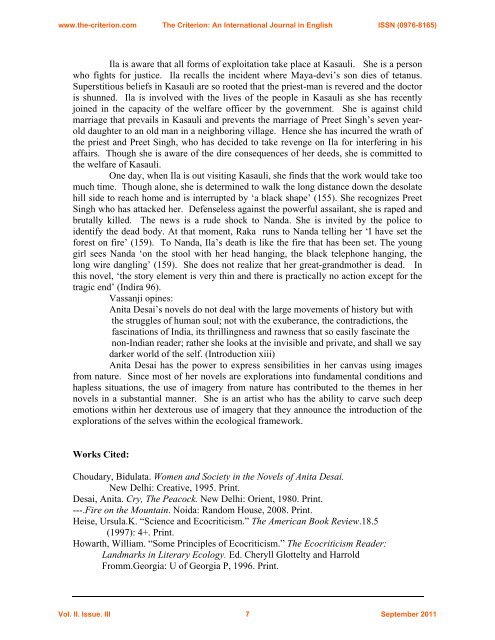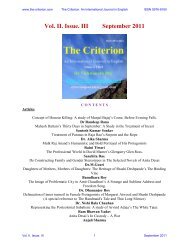Nature and Ecocriticism in Cry,The Peacock and Fire ... - The Criterion
Nature and Ecocriticism in Cry,The Peacock and Fire ... - The Criterion
Nature and Ecocriticism in Cry,The Peacock and Fire ... - The Criterion
You also want an ePaper? Increase the reach of your titles
YUMPU automatically turns print PDFs into web optimized ePapers that Google loves.
www.the-criterion.com <strong>The</strong> <strong>Criterion</strong>: An International Journal <strong>in</strong> English ISSN (0976-8165)<br />
Ila is aware that all forms of exploitation take place at Kasauli. She is a person<br />
who fights for justice. Ila recalls the <strong>in</strong>cident where Maya-devi’s son dies of tetanus.<br />
Superstitious beliefs <strong>in</strong> Kasauli are so rooted that the priest-man is revered <strong>and</strong> the doctor<br />
is shunned. Ila is <strong>in</strong>volved with the lives of the people <strong>in</strong> Kasauli as she has recently<br />
jo<strong>in</strong>ed <strong>in</strong> the capacity of the welfare officer by the government. She is aga<strong>in</strong>st child<br />
marriage that prevails <strong>in</strong> Kasauli <strong>and</strong> prevents the marriage of Preet S<strong>in</strong>gh’s seven yearold<br />
daughter to an old man <strong>in</strong> a neighbor<strong>in</strong>g village. Hence she has <strong>in</strong>curred the wrath of<br />
the priest <strong>and</strong> Preet S<strong>in</strong>gh, who has decided to take revenge on Ila for <strong>in</strong>terfer<strong>in</strong>g <strong>in</strong> his<br />
affairs. Though she is aware of the dire consequences of her deeds, she is committed to<br />
the welfare of Kasauli.<br />
One day, when Ila is out visit<strong>in</strong>g Kasauli, she f<strong>in</strong>ds that the work would take too<br />
much time. Though alone, she is determ<strong>in</strong>ed to walk the long distance down the desolate<br />
hill side to reach home <strong>and</strong> is <strong>in</strong>terrupted by ‘a black shape’ (155). She recognizes Preet<br />
S<strong>in</strong>gh who has attacked her. Defenseless aga<strong>in</strong>st the powerful assailant, she is raped <strong>and</strong><br />
brutally killed. <strong>The</strong> news is a rude shock to N<strong>and</strong>a. She is <strong>in</strong>vited by the police to<br />
identify the dead body. At that moment, Raka runs to N<strong>and</strong>a tell<strong>in</strong>g her ‘I have set the<br />
forest on fire’ (159). To N<strong>and</strong>a, Ila’s death is like the fire that has been set. <strong>The</strong> young<br />
girl sees N<strong>and</strong>a ‘on the stool with her head hang<strong>in</strong>g, the black telephone hang<strong>in</strong>g, the<br />
long wire dangl<strong>in</strong>g’ (159). She does not realize that her great-gr<strong>and</strong>mother is dead. In<br />
this novel, ‘the story element is very th<strong>in</strong> <strong>and</strong> there is practically no action except for the<br />
tragic end’ (Indira 96).<br />
Vassanji op<strong>in</strong>es:<br />
Anita Desai’s novels do not deal with the large movements of history but with<br />
the struggles of human soul; not with the exuberance, the contradictions, the<br />
fasc<strong>in</strong>ations of India, its thrill<strong>in</strong>gness <strong>and</strong> rawness that so easily fasc<strong>in</strong>ate the<br />
non-Indian reader; rather she looks at the <strong>in</strong>visible <strong>and</strong> private, <strong>and</strong> shall we say<br />
darker world of the self. (Introduction xiii)<br />
Anita Desai has the power to express sensibilities <strong>in</strong> her canvas us<strong>in</strong>g images<br />
from nature. S<strong>in</strong>ce most of her novels are explorations <strong>in</strong>to fundamental conditions <strong>and</strong><br />
hapless situations, the use of imagery from nature has contributed to the themes <strong>in</strong> her<br />
novels <strong>in</strong> a substantial manner. She is an artist who has the ability to carve such deep<br />
emotions with<strong>in</strong> her dexterous use of imagery that they announce the <strong>in</strong>troduction of the<br />
explorations of the selves with<strong>in</strong> the ecological framework.<br />
Works Cited:<br />
Choudary, Bidulata. Women <strong>and</strong> Society <strong>in</strong> the Novels of Anita Desai.<br />
New Delhi: Creative, 1995. Pr<strong>in</strong>t.<br />
Desai, Anita. <strong>Cry</strong>, <strong>The</strong> <strong>Peacock</strong>. New Delhi: Orient, 1980. Pr<strong>in</strong>t.<br />
---.<strong>Fire</strong> on the Mounta<strong>in</strong>. Noida: R<strong>and</strong>om House, 2008. Pr<strong>in</strong>t.<br />
Heise, Ursula.K. “Science <strong>and</strong> <strong>Ecocriticism</strong>.” <strong>The</strong> American Book Review.18.5<br />
(1997): 4+. Pr<strong>in</strong>t.<br />
Howarth, William. “Some Pr<strong>in</strong>ciples of <strong>Ecocriticism</strong>.” <strong>The</strong> <strong>Ecocriticism</strong> Reader:<br />
L<strong>and</strong>marks <strong>in</strong> Literary Ecology. Ed. Cheryll Glottelty <strong>and</strong> Harrold<br />
Fromm.Georgia: U of Georgia P, 1996. Pr<strong>in</strong>t.<br />
Vol. II. Issue. III 7 September 2011

















